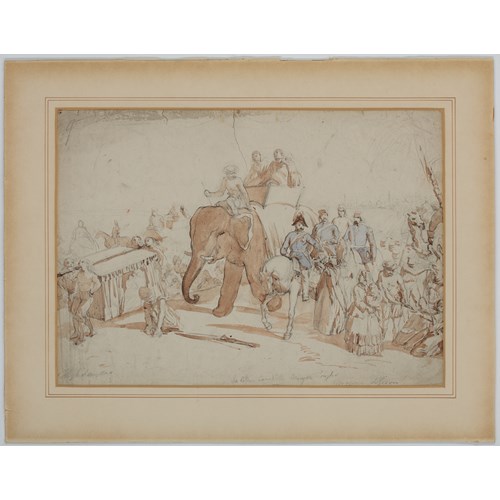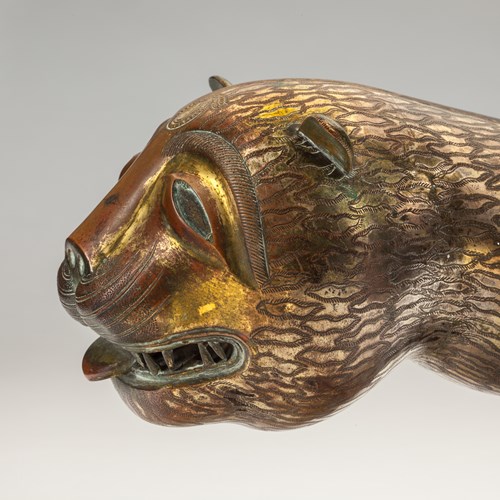Marketplace
Kangxi Famille Verte Plate for the Islamic Market
A rare famille verte plate made for the Islamic market. Contained within a circle of fret, the Basmala is written in cobalt blue in the central medallion, whilst the four cartouches on the rim contain the following dhikr in red:
سُبْحَانَ اللهِ وَالْحَمْدُ للهِ وَلا إِلهَ إِلَّا اللهُ وَاللهُ أَكْبَرُ
Glory to God, Praise be to God, There is no God but Allah, God is Great.
The Arabic is poorly written, suggesting it was copied by someone with little knowledge of the language.
The dish is decorated with typical motifs of famille verte porcelain. The rim is decorated with a green trellis diaper pattern with pink flowers. It is broken up by the four cloud-shaped cartouches. The cavetto is left plain but for 8 red blossoms. A pair of Kangxi famille verte plates in the British Museum, London (registration no. Franks.498.+) have very similar decoration on the rim and cavetto. Though the wells are decorated with landscapes, the diaper pattern rim and four-cloud shaped cartouches resemble the present dish. A further example is held in the Victoria & Albert Museum (accession no. C.1164-1910), featuring comparable trellis decoration interrupted by four cartouches in reserve on the rim. A border of key fret on a green background surrounds the central roundel, which can most commonly be found on foot rings of famille verte bowls, such as MAR.C.84-1912 in the Fitzwilliam Museum, Cambridge. The reverse is decorated with four sprigs of bamboo leaves in red, and the foot is left blank.
Famille verte was produced during the Kangxi era (1662-1722) in Jingdezhen. It is thought to have developed from Swatow-ware, a group of export porcelain made in Zhangzhou and characterised by its limited range of colours, particularly iron red and green. Swatow dishes with Arabic inscriptions in red or green were mass-produced in order to boost trade with Islamic countries such as Indonesia. Examples can be found in the Aga Khan Museum, Toronto (accession no. AKM591) and the Princessehof Ceramic Museum, Leeuwarden (accession no. GAM 0914). Though famille verte porcelain for the Islamic market was produced in Jingdezhen, examples with Arabic inscriptions are extremely rare.
A label reading ‘P. Kyticas Antiquités Objets d’Art’ is stuck on the reverse of this dish. Panayotis Kyticas was an antiques dealer based in Cairo. On his death in 1924, the business retained the name P. Kyticas under the supervision of his son, Denis P. Kyticas. Kyticas family contributed many Egyptian and Chinese artefacts to the British Museum. This dish, part of a set of three, was inherited by the author Hannah Fielding, who grew up in Alexandria, Egypt.
سُبْحَانَ اللهِ وَالْحَمْدُ للهِ وَلا إِلهَ إِلَّا اللهُ وَاللهُ أَكْبَرُ
Glory to God, Praise be to God, There is no God but Allah, God is Great.
The Arabic is poorly written, suggesting it was copied by someone with little knowledge of the language.
The dish is decorated with typical motifs of famille verte porcelain. The rim is decorated with a green trellis diaper pattern with pink flowers. It is broken up by the four cloud-shaped cartouches. The cavetto is left plain but for 8 red blossoms. A pair of Kangxi famille verte plates in the British Museum, London (registration no. Franks.498.+) have very similar decoration on the rim and cavetto. Though the wells are decorated with landscapes, the diaper pattern rim and four-cloud shaped cartouches resemble the present dish. A further example is held in the Victoria & Albert Museum (accession no. C.1164-1910), featuring comparable trellis decoration interrupted by four cartouches in reserve on the rim. A border of key fret on a green background surrounds the central roundel, which can most commonly be found on foot rings of famille verte bowls, such as MAR.C.84-1912 in the Fitzwilliam Museum, Cambridge. The reverse is decorated with four sprigs of bamboo leaves in red, and the foot is left blank.
Famille verte was produced during the Kangxi era (1662-1722) in Jingdezhen. It is thought to have developed from Swatow-ware, a group of export porcelain made in Zhangzhou and characterised by its limited range of colours, particularly iron red and green. Swatow dishes with Arabic inscriptions in red or green were mass-produced in order to boost trade with Islamic countries such as Indonesia. Examples can be found in the Aga Khan Museum, Toronto (accession no. AKM591) and the Princessehof Ceramic Museum, Leeuwarden (accession no. GAM 0914). Though famille verte porcelain for the Islamic market was produced in Jingdezhen, examples with Arabic inscriptions are extremely rare.
A label reading ‘P. Kyticas Antiquités Objets d’Art’ is stuck on the reverse of this dish. Panayotis Kyticas was an antiques dealer based in Cairo. On his death in 1924, the business retained the name P. Kyticas under the supervision of his son, Denis P. Kyticas. Kyticas family contributed many Egyptian and Chinese artefacts to the British Museum. This dish, part of a set of three, was inherited by the author Hannah Fielding, who grew up in Alexandria, Egypt.
More artworks from the Gallery







 Beyond These Shores 4_T638206163545820872.jpg?width=500&height=500&mode=pad&scale=both&qlt=90&format=jpg)

_T638446318994385662.jpg?width=500&height=500&mode=pad&scale=both&qlt=90&format=jpg)